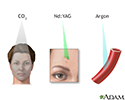Laser therapy
Laser therapy is a medical treatment that uses a strong beam of light to cut, burn, or destroy tissue. The term LASER stands for light amplification by stimulated emission of radiation.
Information
The laser light beam does not pose health risks to the person or medical team. Laser treatment has some of the same risks as open surgery, including pain, bleeding, and scarring. But recovery time from laser surgery is usually faster than recovery from open surgery.
Lasers can be used for many medical purposes. Because the laser beam is so small and precise, it allows health care providers to safely treat tissue without injuring the surrounding area.
Lasers are often used to:
- Treat varicose veins
Treat varicose veins
Varicose veins are swollen, tortuous, and sometimes painful veins that have filled with blood that does not drain out in a normal fashion.
Read Article Now Book Mark Article - Improve vision during eye surgery on the cornea
Eye surgery on the cornea
LASIK is eye surgery that permanently changes the shape of the cornea (the clear covering on the front of the eye). It is done to improve vision and...
 ImageRead Article Now Book Mark Article
ImageRead Article Now Book Mark Article - Repair a detached retina of the eye
Repair a detached retina of the eye
Retinal detachment repair is eye surgery to place a retina back into its normal position. The retina is the light-sensitive tissue in the back of th...
 ImageRead Article Now Book Mark Article
ImageRead Article Now Book Mark Article - Remove parts of the prostate
Remove parts of the prostate
Minimally invasive prostate resection is surgery to remove part of the prostate gland, to treat an enlarged prostate. The surgery will improve the f...
Read Article Now Book Mark Article - Remove kidney stones
Remove kidney stones
Lithotripsy is a procedure that uses shock waves to break up stones in the kidney and parts of the ureter (tube that carries urine from your kidneys ...
 ImageRead Article Now Book Mark Article
ImageRead Article Now Book Mark Article - Remove tumors
Tumors
A tumor is an abnormal growth of body tissue. Tumors can be cancerous (malignant) or noncancerous (benign).
Read Article Now Book Mark Article
Lasers are also often used during skin surgery.
Skin surgery
Laser surgery uses laser energy to treat the skin. Laser surgery can be used to treat skin diseases or cosmetic concerns such as sunspots or wrinkle...
Read Article Now Book Mark ArticleReferences
James WD, Elston DM, Treat JR, Rosenbach MA, Neuhaus IM. Cutaneous laser surgery. In: James WD, Elston DM, Treat JR, Rosenbach MA, Neuhaus IM, eds. Andrews' Diseases of the Skin: Clinical Dermatology. 13th ed. Philadelphia, PA: Elsevier; 2020:chap 38.
Palanker D, Blumenkranz MS. Retinal laser therapy: biophysical basis and applications. In: Sadda SVR, Sarraf D, Freund KB, et al, eds. Ryan's Retina. 7th ed. Philadelphia, PA: Elsevier; 2023:chap 41.
Zaydfudin VM, Hu Y, Adams RB. Principles of preoperative and operative surgery. In: Townsend CM Jr, Beauchamp RD, Evers BM, Mattox KL, eds. Sabiston Textbook of Surgery. 21st ed. St Louis, MO: Elsevier; 2022:chap 10.
Laser therapy - illustration
A laser is used for many medical purposes. Because the laser beam is so small and precise, it enables physicians to safely treat specific tissue without injuring surrounding tissue. Some uses of the laser are retinal surgery, excision of lesions, and cauterization of vascular structures.
Laser therapy
illustration
Laser therapy - illustration
A laser is used for many medical purposes. Because the laser beam is so small and precise, it enables physicians to safely treat specific tissue without injuring surrounding tissue. Some uses of the laser are retinal surgery, excision of lesions, and cauterization of vascular structures.
Laser therapy
illustration
Review Date: 9/9/2023
Reviewed By: Debra G. Wechter, MD, FACS, General Surgery Practice Specializing in Breast Cancer, Virginia Mason Medical Center, Seattle, WA. Also reviewed by David C. Dugdale, MD, Medical Director, Brenda Conaway, Editorial Director, and the A.D.A.M. Editorial team.


